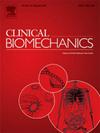Medial longitudinal arch variations and extrinsic foot muscle elasticity: Analysis of mobile, neutral, and rigid arch mobilities
IF 1.4
3区 医学
Q4 ENGINEERING, BIOMEDICAL
引用次数: 0
Abstract
Background
The mobility of the medial longitudinal arch contributes to foot function by accommodating to varying loads during dynamic weight-bearing activities. Physiologically, an external load, or stress, causes deformation in response to the application of load. Elasticity measures may offer insight into how load is distributed amongst synergistic muscles of the foot. The study's objective was to compare elasticity of extrinsic foot muscles across different categories of medial longitudinal arch mobility.
Methods
In this within- and between-subjects exploratory design, shear wave elastography was used to measure elasticity of the tibialis anterior, tibialis posterior, peroneal longus, and peroneal brevis in a non-weight-bearing and weight-bearing condition. Participants (N = 109) were classified into mobile, neutral, and rigid arch categories using the Arch Height Index Measurement System.
Findings
In non-weight-bearing, a significant interaction (p = 0.049) revealed elasticity of the tibialis posterior was significantly (p = 0.003, d = 0.90) greater in the rigid arch group when compared to the mobile arch group. In weight-bearing, a significant main effect (p = ≤0.001) for elasticity revealed all muscles, except the tibialis anterior and peroneal brevis comparison, were significantly (p = ≤0.001) different from one another (d = 0.75–3.09).
Interpretation
This study presents a new approach to clinical measures of muscle elasticity using shear wave elastography. The findings offer valuable insight into the mechanical properties of extrinsic foot muscle elasticity across medial longitudinal arch mobility categories and the potential load sharing between synergistic muscles. Results showed elasticity of the tibialis posterior differed between mobile and rigid arches. This information may help inform future research in biomechanics and rehabilitation.
内侧纵弓变化和外在足部肌肉弹性:活动、中性和刚性足弓活动的分析
背景:在动态负重活动中,内侧纵弓的可移动性通过适应不同的负荷有助于足部功能。从生理学上讲,外部载荷或应力会引起变形,以响应载荷的施加。弹性测量可以提供洞察负载是如何分布在脚的协同肌肉。该研究的目的是比较不同类别的内侧纵足弓活动的外在足肌的弹性。方法在受试者内部和受试者之间的探索性设计中,采用横波弹性成像测量胫骨前肌、胫骨后肌、腓骨长肌和腓骨短肌在非负重和负重情况下的弹性。使用足弓高度指数测量系统将参与者(N = 109)分为活动足弓、中性足弓和刚性足弓三类。在非负重情况下,显著的相互作用(p = 0.049)显示,刚性弓组的胫骨后肌弹性明显(p = 0.003, d = 0.90)大于活动弓组。在负重时,弹性的显著主效应(p =≤0.001)表明,除胫骨前肌和腓短肌外,所有肌肉之间的差异显著(p =≤0.001)(d = 0.75-3.09)。本研究提出了一种使用剪切波弹性成像测量肌肉弹性的新方法。研究结果提供了有价值的见解外源性足部肌肉弹性的机械特性跨内侧纵弓移动类别和协同肌肉之间的潜在负荷分担。结果显示胫骨后肌弹性在活动弓和刚性弓之间存在差异。这些信息可能有助于为未来的生物力学和康复研究提供信息。
本文章由计算机程序翻译,如有差异,请以英文原文为准。
求助全文
约1分钟内获得全文
求助全文
来源期刊

Clinical Biomechanics
医学-工程:生物医学
CiteScore
3.30
自引率
5.60%
发文量
189
审稿时长
12.3 weeks
期刊介绍:
Clinical Biomechanics is an international multidisciplinary journal of biomechanics with a focus on medical and clinical applications of new knowledge in the field.
The science of biomechanics helps explain the causes of cell, tissue, organ and body system disorders, and supports clinicians in the diagnosis, prognosis and evaluation of treatment methods and technologies. Clinical Biomechanics aims to strengthen the links between laboratory and clinic by publishing cutting-edge biomechanics research which helps to explain the causes of injury and disease, and which provides evidence contributing to improved clinical management.
A rigorous peer review system is employed and every attempt is made to process and publish top-quality papers promptly.
Clinical Biomechanics explores all facets of body system, organ, tissue and cell biomechanics, with an emphasis on medical and clinical applications of the basic science aspects. The role of basic science is therefore recognized in a medical or clinical context. The readership of the journal closely reflects its multi-disciplinary contents, being a balance of scientists, engineers and clinicians.
The contents are in the form of research papers, brief reports, review papers and correspondence, whilst special interest issues and supplements are published from time to time.
Disciplines covered include biomechanics and mechanobiology at all scales, bioengineering and use of tissue engineering and biomaterials for clinical applications, biophysics, as well as biomechanical aspects of medical robotics, ergonomics, physical and occupational therapeutics and rehabilitation.
 求助内容:
求助内容: 应助结果提醒方式:
应助结果提醒方式:


